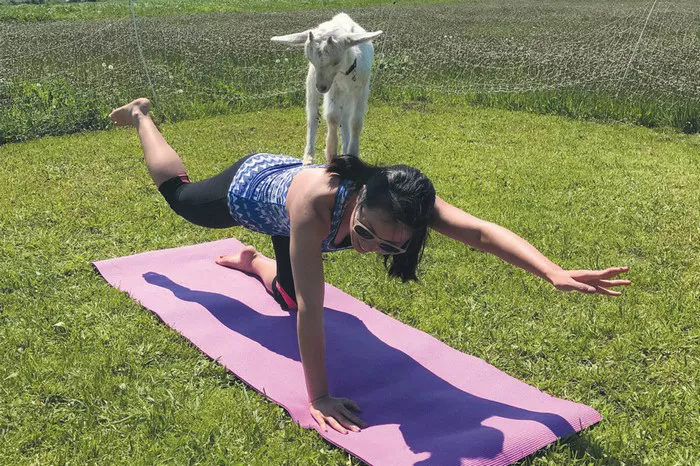In recent years, the wellness industry has seen a surge in unique and unconventional practices, one of which is goat yoga. Combining the benefits of yoga with the therapeutic presence of goats, this trend has captured the interest of many individuals seeking both physical and mental well-being. If you’re considering starting a goat yoga business, you’re tapping into a niche market with significant potential for growth. However, like any business venture, it requires careful planning, preparation, and execution to ensure success.
Understanding the Concept of Goat Yoga
Goat yoga is a variant of traditional yoga that involves practicing yoga poses in the presence of goats. Originating in Oregon in 2016, this practice quickly gained popularity for its ability to provide stress relief, promote mindfulness, and foster a sense of joy and connection with nature. During a goat yoga session, participants engage in yoga poses while goats roam freely around them, often interacting with the participants by nuzzling, climbing, or simply being present.
Market Research and Analysis
Before diving into starting your goat yoga business, it’s crucial to conduct thorough market research to assess the demand and competition in your area. Identify potential customers, such as yoga enthusiasts, animal lovers, tourists, and individuals seeking unique wellness experiences. Survey local yoga studios, wellness centers, and community centers to gauge interest and understand pricing structures.
Additionally, research existing goat yoga businesses in your region or neighboring areas. Analyze their offerings, pricing, marketing strategies, and customer reviews to identify gaps in the market that your business can fill. Consider factors such as location, accessibility, and the availability of suitable goat breeds for your sessions.
Business Planning and Legal Considerations
Developing a comprehensive business plan is essential for laying the foundation of your goat yoga venture. Outline your business objectives, target market, pricing strategy, marketing plan, and financial projections. Determine the legal structure of your business, whether it’s a sole proprietorship, partnership, limited liability company (LLC), or corporation, and register your business accordingly.
Ensure compliance with local regulations and obtain any necessary permits or licenses for operating a yoga business and keeping animals on your premises. Consult with legal and financial advisors to navigate zoning laws, liability insurance requirements, and tax obligations associated with your business.
Securing Suitable Facilities and Equipment
Finding the right location for your goat yoga classes is crucial to the success of your business. Look for venues with ample outdoor space, such as farms, ranches, or open fields, where goats can roam freely without posing a risk to participants or property. Ensure that the venue is easily accessible, has adequate parking facilities, and complies with zoning regulations for hosting public events.
Invest in quality yoga equipment, including mats, blocks, straps, and blankets, to provide a comfortable and safe experience for your participants. Consider purchasing portable fencing or barriers to create designated areas for yoga practice and goat interaction within your chosen venue.
Acquiring and Training Goats
Selecting the right goats for your business is crucial for ensuring the safety and enjoyment of your participants. Choose friendly, sociable goats with calm temperaments that are comfortable being around people. Consider partnering with local farms or goat breeders to source your goats or consider adopting rescue goats to support animal welfare causes.
Provide proper training and socialization for your goats to acclimate them to human interaction and yoga environments. Familiarize them with common yoga poses and teach them to remain calm and gentle around participants. Regular veterinary care, grooming, and nutrition are essential for maintaining the health and well-being of your goats.
Developing Unique Yoga Sessions
Differentiate your goat yoga business by offering a variety of themed yoga sessions and experiences tailored to the preferences and interests of your target audience. Experiment with different yoga styles, such as hatha, vinyasa, or restorative yoga, and incorporate elements of mindfulness, meditation, or relaxation techniques into your sessions.
Consider hosting special events such as sunrise or sunset yoga sessions, full moon yoga gatherings, or yoga retreats that offer a holistic wellness experience. Collaborate with local yoga instructors, wellness practitioners, or guest speakers to enhance the diversity and appeal of your offerings.
Marketing and Promotion Strategies
Effective marketing and promotion are essential for attracting customers and generating buzz around your goat yoga business. Develop a strong online presence by creating a professional website, engaging social media profiles, and utilizing digital marketing channels such as email newsletters, blog content, and online advertising.
Harness the power of visual storytelling by sharing captivating photos and videos of your goat yoga sessions on social media platforms like Instagram, Facebook, and YouTube. Encourage satisfied customers to leave positive reviews and testimonials on your website and social media pages to build credibility and trust with potential clients.
Collaborate with local businesses, yoga studios, wellness centers, and tourism organizations to cross-promote your goat yoga offerings and reach a wider audience. Attend community events, farmers’ markets, and festivals to showcase your business and network with potential customers.
Ensuring Safety and Liability Protection
Prioritize the safety and well-being of your participants and goats by implementing strict safety protocols and guidelines during your goat yoga sessions. Conduct thorough risk assessments of your venue and equipment to identify potential hazards and take necessary precautions to mitigate them.
Educate participants about proper yoga etiquette, including respecting the personal space of goats, avoiding sudden movements or loud noises, and following instructions from the instructor. Have trained staff or volunteers on hand to supervise the interactions between participants and goats and intervene if necessary.
Invest in liability insurance coverage to protect your business against potential lawsuits or claims arising from accidents, injuries, or property damage during your goat yoga sessions. Consult with insurance providers specializing in small businesses or animal-related activities to ensure adequate coverage for your specific needs.
Monitoring Performance and Adaptation
Continuously monitor the performance of your goat yoga business and solicit feedback from customers to identify areas for improvement and innovation. Track key performance indicators such as attendance rates, customer satisfaction scores, and revenue metrics to gauge the success of your business initiatives.
Stay flexible and adaptable to changing market trends, customer preferences, and external factors that may impact your business operations. Experiment with new ideas, offerings, or partnerships to stay relevant and competitive in the dynamic wellness industry landscape.
Conclusion
Starting a goat yoga business offers a unique opportunity to combine passion for yoga, love for animals, and entrepreneurial spirit into a rewarding and fulfilling venture. By following these steps and strategies, you can lay the groundwork for a successful and sustainable goat yoga business that brings joy, relaxation, and well-being to your community.
Remember to approach your business with dedication, creativity, and a commitment to excellence, and you’ll be well on your way to making a positive impact in the lives of your participants and goats alike.
FAQs:
Is yoga a profitable business?
Yes, yoga can be a profitable business for those who are able to attract a steady stream of clients and manage their expenses effectively. Successful yoga businesses often offer a variety of classes, workshops, retreats, and merchandise to generate revenue.
How to start a yoga business with no money?
Starting a yoga business with no money requires creativity and resourcefulness. Consider offering donation-based classes in public parks or community centers to minimize overhead costs. Utilize free or low-cost marketing strategies such as social media, word-of-mouth, and community partnerships to attract clients. Additionally, bartering services with other businesses or renting space on a per-use basis can help reduce expenses.
How do yoga studios make money?
Yoga studios make money primarily through class fees, memberships, and packages sold to clients. They may also generate revenue from workshops, retreats, teacher training programs, retail sales of yoga apparel and accessories, as well as renting out studio space for events or private sessions. Additionally, some studios offer online classes or subscription-based platforms to reach a wider audience and diversify their income streams.
















